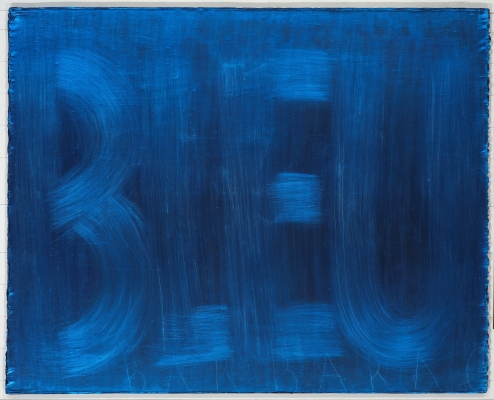According to the painter, “the task of the project is to study and creatively develop a symbiosis of almost monochrome painting with the written word.”
In the past too, Barbara Gayle rarely painted a word, but this time the words are not a poetic supplement, but a research instrument equivalent to colour.
Barbara Gaile has said that “by applying different languages, within each colour I will try to create its autonomous expression, its embodiment to the maximum in a painting. At the same time, they are very subjective treatments of colours and words that are simultaneously both universal and generalized, which should open up the possibilities for many individual interpretations.”
The artist found the rational basis for this ambitious series of works through extended familiarisation with the research on current and historical manifestations of colours. Colour has had great significance in terms of content In Latvian folklore and poetry too, For example, “White came the countrywoman…”, “My white mother…” or Rainis’s “The sun will dance again in three colours. Soon blue, soon green, soon red”.
The origins of Barbara Gaile’s idea for this series of paintings lie in the seemingly chaotic graffiti, scratchings and inscriptions of the urban environment, that is, in the non-commercial, non-advertising visual pluralism of cities.
On the other hand, the poetic impulse was literally Arthur Rimbaud’s poem “Vowels” (“Voyelles”), in which Rimbaud assigns a particular colour to each vowel – A black, E white, I red, U green, O blue (“A noir, E blanc, I rouge, U vert, O bleu..”)
Having lived in Paris since 1997 and being an educated, intellectual person interested in art (including the art of words), Barbara Gaile is able to understand all the verses of the French poet genius down to the nuances. However, unlike the fiery Rimbaud, whose red is “spat blood, smile of beautiful lips in anger or in the raptures of penitence …”, Barbara Gaile’s painting series is a well-structured, laconic extension of the boundaries of painting. It is a conceptual, but at the same time a sensually material carrier of a coded message.
This body of artworks began with two grey paintings, “Yes” and “No”. They introduced the phonetic word games of the series, which appeared in separate paintings as the names of colours in different languages — bleu, grigio, pink or silber. With this exhibition, Barbara Gaile’s colour nuances have been joined by words with their semantic nuances.
Relief comes into the paintings with Braille, which in two works highlights black and white in terms of content.
Barbara Gaile’s series of paintings “Colours” is an indication of the potential possibilities of painting, when the heightened intensity of feelings and thoughts, talent, professionalism and clarity about the task allows one to overcome decorativeness and create a miracle of art.
Barbara Gaile acquired her professional education at the Janis Rozentāls Riga School of Art (1987) and in the Painting department of the Latvian Academy of Art (1995), graduating as the first student whose diploma work was a set of several abstract works. The artist has had many important solo exhibitions beginning in 1994. Of special note were her impressive solo exhibition “Pearls” in the White Hall of the Latvian National Museum of Art in 2010 and “Heaven” at Mark Rothko Arts Centre in Daugavpils in 2016. The artist has participated in many ambitious group exhibitions and won several prizes. For the annual exhibitions of the Soros Foundation’s Latvian Centre for Contemporary Art, “State” (1994) and “Geo-Ģeo” (1997), she created monumental outdoor painting projects, with the last being awarded the Grand Prix by an international jury.
Text: Helēna Demakova





